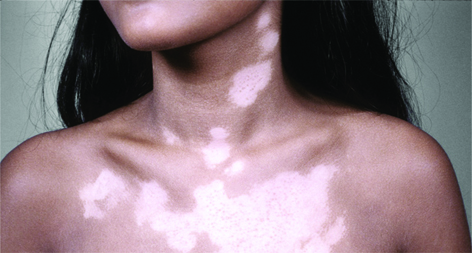By Charles Camisa, MD
What is vitiligo?


How does vitiligo behave?
When vitiligo first appears, the affected skin gets lighter in slowly enlarging dots and circles which may join together covering large areas of the body. In light-skinned people the difference between vitiligo and their normal skin may be difficult to detect until they get tanned. In dark-skinned individuals, the early changes are very obvious and distressing and eventually become bone-white. If the affected skin is hairy, the hair may also turn white. Unfortunately, in some cultures in India and Africa, people with vitiligo are ostracized because they are believed to have an infectious disease. Vitiligo is definitely not an infection and is not contagious in any way, however, the abnormality of the immune system might run in families.
Vitiligo can occur on any part of the body skin, but it does have a tendency to involve skin overlying joints or bony prominences such as the elbows, knees, and backs of the hands and feet. The face, neck, underarms, and private areas such as the nipples and genitalia are also frequently affected.to improve vitiligo, and occasionally one sees spontaneous re-pigmentation. When areas of vitiligo containing small dots of brown pigmentation are seen, the patient has a better prognosis. Long-standing, unchanging vitiligo portends a worse prognosis. Soft smooth skin such as the face and neck have a better chance of re-pigmentation than bony areas such as elbows, knees, and knuckles. By far, the treatments that work best include exposure to ultraviolet light.
How can I get ultraviolet light treatments?
Sunlight Natural sunlight of course contains ultraviolet light, but it is usually ineffective for vitiligo because the depigmented skin burns easily before any remaining pigment- producing cells can be stimulated to make melanin. Although the skin appears white on the surface, there are probably active melanocytes residing deeper in the skin in hair follicles and sweat glands. The latter structures are found in higher numbers on the face and neck which may account for the ability of these areas to respond more quickly. It is important to note that a sunburn or any other type of injury to the normal skin may induce more vitiligo in the injured area. PUVA In ancient Egyptian times, a plant extract called Psoralen was discovered which when combined with long wave ultraviolet light called UVA, helped to repigment vitiligo. This treatment is now called PUVA (Psoralen + UVA=PUVA). Recently, it has been determined that after many PUVA treatment exposures which are required for vitiligo, when the Psoralen is ingested as capsules, the risk of skin cancer is markedly increased. Narrowband UVB Short wave narrowband ultraviolet B (NBUVB) without Psoralen was tried next and found to be just as successful as PUVA at repigmenting skin. The time of exposure to UVB is gradually raised to avoid burning of the normal skin while producing “pinkness” of the vitiligo. The risk of skin cancer does not seem to be increased by NBUVB, but this possibility must always be borne in mind, especially if patients also overexpose themselves to sunlight and tanning beds that deliver mostly UVA. Polypodium leucotomos (fern plant) extract Another plant that has attracted our attention is the tropical fern Polypodium leucotomos. When ingested, fern extracts have been shown to prevent sunburn and protect skin of people who have photosensitive skin. It has several different actions on skin: 1) potent anti-oxidant; 2) reduces cell death caused by sunburn; 3) prevents DNA damage caused by UVB which could lead to skin cancer; 4) reduces the number of mast cells in skin which can release inflammatory chemicals such as histamine.
Study of fern extract in treatment of vitiligo
In 2007 Polypodium leucotomos extract was investigated in the treatment of vitiligo in 50 patients at a university in the Netherlands. Half of the patients received narrowband ultraviolet B (NBUVB) twice weekly plus the fern extract daily in capsules by mouth and half received NBUVB alone for 6 months. Results showed that about twice as many patients receiving the fern extract experienced repigmentation of the head and neck areas.
Our Recommendations for Treating Vitiligo After reviewing the above investigations, we recommend that our patients receive the treatment of first choice, NBUVB delivered in our offices by either a full body cabinet or by the targeted Xtrac laser for therapy of extensive or limited vitiligo skin lesions, respectively. We also advise patients to take the Polypodium leucotomos extract in Heliocare, one or two capsules daily, especially if vitiligo involves the head and neck areas, in order to enhance repigmentation.
More About Heliocare (fern plant extract) Polypodium leucotomos fern plant extract is a non-prescription product that is classified as a food supplement rather than a drug.
The brand that I am most familiar with and have experience with is called Heliocare. It was recently mentioned as a sunscreen pill in the popular magazines For Women First and Consumer Reports. Heliocare contains 240 mg of the fern extract plus green tea extract and beta-carotene which also act as anti-oxidants. No serious side-effects have been reported, but I would not give it to children under 12 years of age or to women who are pregnant or breast-feeding. It costs about a dollar per capsule, but prices vary. It is available at our offices.
Depigmenting the Skin
A patient may have vitiligo so severe and extensive that more than 50% of the body surface area is affected. In such a circumstance, especially if there is a poor response to UVB + Heliocare treatment, complete depigmentation of the skin may be considered to even out the color of the skin. This can be accomplished with a potent prescription bleaching ointment after several months of daily applications to the skin. This treatment is rarely used because the result is irreversible and may drastically alter the person’s appearance.
1-800-591-DERM (3376)
www.RiverchaseDermatology.com
 Southwest Florida's Health and Wellness Magazine Health and Wellness Articles
Southwest Florida's Health and Wellness Magazine Health and Wellness Articles

